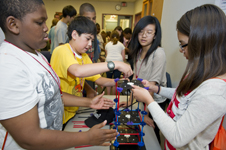Amid the collapsing K’NEX, lots of intuitive science learning

Toy structures perched on a shaker board began to wobble and twist at the start of a computerized earthquake. The magnitude increased and the structures lost their stability and crumbled to the ground. Playful screams broke out.
“I was just closing my eyes, going ‘Oh no, oh no, oh no,’ ” said 12 year-old Sophia Madden, whose team designed the longest lasting of five model towers made of plastic K’NEX toys.
Madden is among some four-dozen middle school students who are participating in the ExxonMobil Bernard Harris Summer Science Camp.
The free, two-week program — run by Northeastern’s Center for STEM Education —gives students the chance to work alongside Northeastern faculty, staff and students on projects aimed at increasing their knowledge and experience in the areas of science, technology, engineering and mathematics (STEM). The program is coordinated by co-executive directors Claire Duggan, Richard Harris and Rachelle Reisberg.
“It has turned out to be a really good way to learn different aspects of science and find out that there are a lot of really different kinds of scientists out there,” said Mariama Camara, a 12-year-old from Stoughton, Mass. “It’s actually really creative. It isn’t just a bunch of boring experiments.”
As part of the camp, students will build model bridges designed to withstand heavy loads and tolerate exterior forces, like earthquakes.
Each activity combines academic and real world strategies for solving engineering problems. Yesterday’s activity, for example, began with a brief lecture on basic engineering principals before the students were divided into groups to test and design their own structures.
Without realizing it, students designed experiments using the scientific method. They developed a hypothesis on how different structures would handle the force of an earthquake, tested their structures by attempting to mimic the forces of an earthquake and made changes they felt would improve the structure.
“You don’t even really need to expose them to too much of the scientific process,” said Seda Gokyer, the PhD student who gave students background information and then facilitated the experiment. “Intuitively, they can figure it out, trying and seeing what works and what does not.”
Next week, astronaut Bernard Harris — the program’s namesake and the first African American astronaut to conduct a spacewalk outside the space shuttle — will address the camp’s participants.





